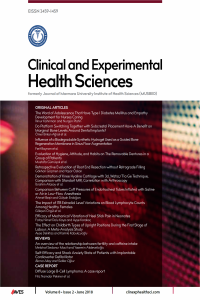Abstract
Keywords
References
- Pirbudak CL, Bacaksız BD, Ovayolu N. The nurse factor ın pain therapy. Gaziantep Medical Journal 2008; 14: 53-8.
Abstract
Objective: One of the most frequently observed painful procedures during
newborn hospitalization is the neonatal heel prick. The use of vibration
therapy in newborn pain control can be a preferred method for its non-invasive,
cheap, and easy applicability. This study aimed to evaluate effectiveness
of mechanical vibration application to avoid pain sensation during
heel puncture in newborns.
Methods: This was a prospective single-center, placebo-controlled,, prospective
randomized study. The study sample composed of healthy neonates born between
37 and 42 weeks of gestation in Medeniyet University Göztepe Training
and Research Hospital. Sixty healthy neonates born in the study hospital between
September 2012 and March 2013 and who matched the inclusion criteria
after parental consent was obtained were included in the study. Heel puncture
was applied to the infants during routine testing for phenylketonuria. It was recorded
that all of the newborns demographic characteristics, heart rate,oxygen
saturation and body tempature measurement at the process. All applications
was saved to video camera, then displayed followed and the NIPS was scored
by the investigator. The Cronbach’s alpha coefficient for the NIPS scoring system
was 0.85 during the procedure and 0.87 after the procedure in this study.
Results: Before procedure and during procedure the NIPS point average
of the experiment group is calculated by (0.967±1.771) and (1.733±2.050)
. For the control group, before and during application the NIPS point average
is (3,567±1,775) and (4,533±1,907), respectively (p<0.05). In both
groups Newborns post-procedure NIPS score results was higher than
during procedure NIPS score and it was statistically significant (p<0.05).
Conclusion: Mechanical vibration is found to be effective in decreasing
pain sensation in neonates.
Keywords
References
- Pirbudak CL, Bacaksız BD, Ovayolu N. The nurse factor ın pain therapy. Gaziantep Medical Journal 2008; 14: 53-8.
Details
| Primary Language | English |
|---|---|
| Journal Section | Articles |
| Authors | |
| Publication Date | June 15, 2018 |
| Submission Date | April 12, 2017 |
| Published in Issue | Year 2018 Volume: 8 Issue: 2 |


